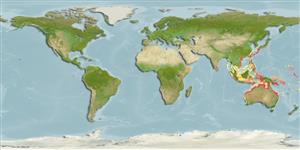>
Callionymiformes (Dragonets) >
Callionymidae (Dragonets)
Etymology: Callionymus: Greek, kallion, comparative of kallos = beautiful + Greek, onyma = name; with a better name .
Environment: milieu / climate zone / depth range / distribution range
Ecología
marino demersal; rango de profundidad 5 - 38 m (Ref. 75992). Tropical
Southwest Pacific.
Tamaño / Peso / Age
Maturity: Lm ? range ? - ? cm
Max length : 14.3 cm TL macho / no sexado; (Ref. 30504)
Espinas dorsales (total): 4; Radios blandos dorsales (total): 9; Radios blandos anales: 9. Body brown above, closely speckled with whitish spots, whitish below. First dorsal fin in males light, spines with faint dark spots. In females distally dusky. Second dorsal fin, caudal fin, pectoral and pelvic fins with darker spots. Anal fin with a broad dusky margin. First and second spine of first dorsal fin with filaments of equal length, at least 2 times longer than first ray of second dorsal fin. Third and fourth spines of first dorsal fin not filamentous (Ref 42832).
Life cycle and mating behavior
Madurez | Reproducción | Puesta | Huevos | Fecundidad | Larva
Gloerfelt-Tarp, T. and P.J. Kailola, 1984. Trawled fishes of southern Indonesia and northwestern Australia. Australian Development Assistance Bureau, Australia, Directorate General of Fishes, Indonesia, and German Agency for Technical Cooperation, Federal Republic of Germany. 407 p. (Ref. 5978)
IUCN Red List Status (Ref. 130435)
Threat to humans
Harmless
Human uses
Pesca deportiva: si
Más información
Nombres comunesSinónimosMetabolismoDespredadoresEcotoxicologíaReproducciónMadurezPuestaAgregación para la puestaFecundidadHuevosEgg development
ReferenciasAcuiculturaPerfil de acuiculturaRazasGenéticaElectrophoresesheritabilidadEnfermedadesProcesamientoNutrientsMass conversion
Herramientas
Special reports
Download XML
Fuentes de Internet
Estimates based on models
Preferred temperature (Ref.
123201): 24.1 - 28.8, mean 27.6 °C (based on 322 cells).
Phylogenetic diversity index (Ref.
82804): PD
50 = 0.5000 [Uniqueness, from 0.5 = low to 2.0 = high].
Bayesian length-weight: a=0.00912 (0.00408 - 0.02036), b=2.77 (2.59 - 2.95), in cm total length, based on LWR estimates for this Genus-body shape (Ref.
93245).
Nivel trófico (Ref.
69278): 3.3 ±0.4 se; based on size and trophs of closest relatives
Resiliencia (Ref.
120179): Alto, población duplicada en un tiempo mínimo inferior a 15 meses (Preliminary K or Fecundity.).
Fishing Vulnerability (Ref.
59153): Low vulnerability (10 of 100).
